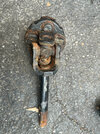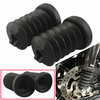islandbayy
Active Member
Just want to update, at about 8 months since I made that video and used PTFE Lube. No sticking steering or any issues at all yet. Made it through a Wisconsin Winter, numerous carwashes and still going good with no re-application of PTFE Lube When I rotate tires the next time end of July, I'll take a closer look, and will likely give it a quick booster spray. From what I can see though, No grime is stuck on the parts. Using regular grease will attract and keep road grime trapped, where as the PTFE not much for it to stick to.




